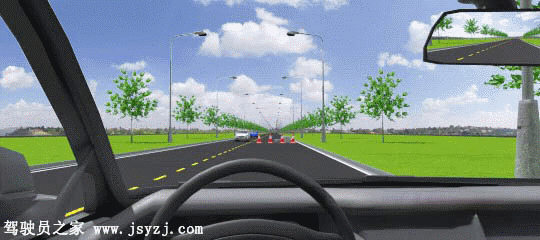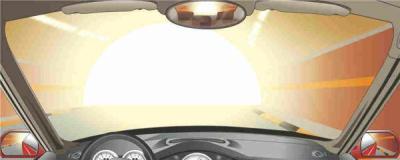1、The cross-hatched marking indicates an area where vehicle drivers are not allowed to stop.

A、Right
B、Wrong
Answer:A
2、When driving on a muddy road, the driver should hold the steering wheel firmly and speed up to pass through.
A、Right
B、Wrong
Answer:B
3、As shown in this flash, what should the motor vehicle driver do when encounters this situation?

A、Use the mergency brake
B、Turn sharply and pass rapidly
C、Slide over rapidly without encountering collision
D、Stop smoothly
Answer:D
4、When a motor vehicle slides sideways, how should the driver adiust the direction?
A、If the front wheels skid sideways, turn the steering wheel in the direction of the skid
B、If the front wheels skid sideways, turn the steering wheel in the opposite direction of the skid
C、If the rear wheels skid sideways, turn the steering wheel in the direction of the skid
D、If the rear wheels skid sideways, turn the steering wheel in the opposite direction of the skid
Answer:BC
5、After setting off from a roadside, motor vehicle drivers should watch both sides of the road, turn left and drive into the normal lane slowly.
A、Right
B、Wrong
Answer:A
6、Motor vehicles on this kind of road are only allowed to overtake the vehicle in front from left.

A、Right
B、Wrong
Answer:A
7、When passing a sharp curve, motor vehicle drivers may overtake if there are few other vehicles on the road.
A、Right
B、Wrong
Answer:B
8、The sign on the right warns for disabled people ahead.

A、Right
B、Wrong
Answer:A
9、If a motor vehicle deviates from the straight direction due to steering failure, what should be done by thedriver in order to reduce speed and stop the vehicle as soon as possible?
A、Gently depressing the brake pedal
B、Pulling up the handbrake
C、Immediately changing to a low gear to reduce speed
D、Decisively and continuously depressing and releasing the brake pedal
Answer:D
10、It is not safe for a female driver to wear high heels to drive a vehicle.
A、Right
B、Wrong
Answer:A
11、When there is a sudden braking failure on a downhill road, in which ones of the following ways can drivers reduce speed?
A、Driving onto the emergency lane and reduce speed and stop there
B、Rubbing the vehicle body against the rocks or trees on roadside
C、Pulling up the handbrake first
D、Immediately changing to a low gear
Answer:ABD
12、The sign on the right warns of a village or town ahead suggesting a 30km/hour speed.

A、Right
B、Wrong
Answer:A
13、What should the driver do upon seeing this sign?

A、Slow down, look and pass slowly
B、Sound the horn to drive them away
C、Go through from the spaces between animals
D、Drive slowly and drive them away from the motor venicle
Answer:A
14、What's the most frequent problem for driving on a muddy road?
A、High resistance force
B、Sideways slide
C、The motor vehicle bumps
D、Steering failure
Answer:B
15、When a motor vehicle approaches the exit of a tunnel the driver should firmly hold the steering wheel to prevent any harmful effects of a strong side wind.

A、Right
B、Wrong
Answer:A
16、The sign on the right indicates notice by sounding the horn.

A、Right
B、Wrong
Answer:B
17、The motor vehicle may promptly overtake the vehicle in front from the left side in this situation.

A、Right
B、Wrong
Answer:B
18、The sign on the right warns of a ferry crossing 100 meters after turning right at the intersection ahead.

A、Right
B、Wrong
Answer:A
19、When the windscreen of a motor vehicle on the highway is cracked by flying rocks or debris which makes visibility poor, the driver should reduce speed gradually, turn on the hazardlamps, drive to a place where it will not obstruct the traffic flow and stop there.
A、Right
B、Wrong
Answer:A
20、When such circumstances happen suddenly, drivers should reduce speed in a timely fashion or stop to yield.

A、Right
B、Wrong
Answer:A
21、When driving in thick fog causing poor visibility on the expressway, the driver should apply emergency braking to stop at once.
A、Right
B、Wrong
Answer:B
22、It is a bad habit for a driver to put his left arm on the window of the vehicle or hold the gear lever in his right hand for a long time.
A、Right
B、Wrong
Answer:A
23、The sign on the right warns of a wildlife protection area ahead.

A、Right
B、Wrong
Answer:B
24、When a motor vehicle encounters thick fog on an expressway and the visibility is poor, the driver should immediately brake and stop.
A、Right
B、Wrong
Answer:B
25、If a fast moving vehicle has a steering failure, using emergency braking can easily cause an overturn.
A、Right
B、Wrong
Answer:A